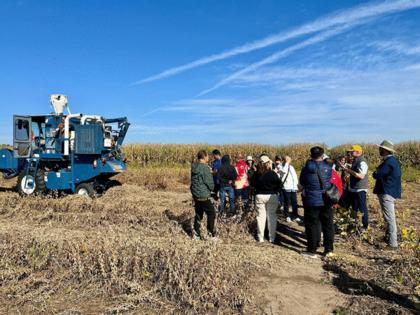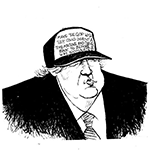Minnesota soybean farmers host Southeast Asia buyers as trade war with China persists
Published in Business News
A group of Indonesian farmers traveled 9,000 miles to find food for their chickens.
That’s how good Minnesota soybeans are.
“Our soybeans from the north are very clean, low disease, low foreign material and dry, and the quality of the protein may be better than the quality of the protein from higher-protein soybeans,” Seth Naeve, a University of Minnesota soybean expert, told the prospective buyers. “It’s a different perspective than crude protein content, but we’re trying to focus on what the animal wants.”
Soybean farmers are in dire straits this year as China refuses to buy U.S. soy in retaliation for President Donald Trump’s tariffs, causing prices to tank and harvests to sit unsold. But farmers aren’t just waiting around for a federal bailout; they’re looking for alternative buyers.
“We’ve got to beat the bushes and utilize these trade teams and show them what a great product the U.S. has,” said Joel Schreurs, a farmer in Tyler and board member of the Minnesota Soybean Research & Promotion Council. “It’s plentiful, and it’s relatively cheap at this point in time. Now’s the time to buy, if you’re a foreign entity.”
Last week’s tour group, which also included soybean buyers from Vietnam and Thailand, is part of a broader and long-running effort to build export markets for U.S. soybeans. Schreurs, who also serves on the U.S. Soybean Export Council, said he’s hosted probably 20 trade teams in almost as many years at his farm, including the group from Southeast Asia.
“We’re working all over the world to develop new markets,” he said.
There are about 26,000 soybean farmers in Minnesota, and more than half of the state’s soybean crop ends up as international exports, largely to feed livestock, according to the Minnesota Soybean Growers Association.
In most years, a quarter of the state’s entire crop heads to China. Minnesota farmers planted about 7 million acres of soy this year.
Reliance on China has contributed to soybean farmers’ vulnerability in the ongoing trade war, but it fueled some very profitable years.
Nationally, exports to China roughly tripled between 2007 and 2017, propelling the price of soybeans in the process and prompting farmers to plant millions more acres of the legume. Then came the first trade war, which wiped out Chinese soybean purchases in 2018 and 2019. And now, China has not ordered a shipment of U.S. soy since May.
The American Soybean Association has called for a new trade deal with China, whose citizens have grown richer this century and are eating more meat as a result, boosting the need for soybeans for animal feed.
And while Trump has pledged to use tariff revenue to compensate farmers for the losses they’ll be taking on this year’s crop, such a move requires Congressional approval. And that’s unlikely, at least until the government shutdown concludes.
In the meantime, U.S. farmers need new soybean buyers, whether via national efforts or local farm tours, to feed livestock elsewhere.
“With the crop tour, they can see the full process and really understand our supply chain and why we are a clear advantage to our international customers,” said Glen Groth, a Minnesota farmer and chair of Northern Soy Marketing, which advocates for Minnesota and South Dakota soybean farmers.
Schreurs said additional efforts like Soy Excellence Centers, which operate as training programs for agribusiness employees in developing markets, help build a pipeline of buyers who can advocate for American soy.
“The whole premise is to train managers who will request U.S. product,” he said. “Working in Central and South America, that’s actually been one of the brighter spots in terms of market-share gains.”
Bringing buyers on the ground in Minnesota is still vital, Schreurs said: “It’s important to understand who they are, what they need. And on the other side, you tend to buy from people you like.”
As potential buyers from Southeast Asia studied a handful of soybeans freshly harvested from the University of Minnesota’s test plot Sept. 29, Gov. Tim Walz declared “Soybean Week” to highlight the damage tariffs have done to market access.
“Despite these challenges,” the governor’s proclamation read, “Minnesota farmers continue to demonstrate resilience, innovation and dedication to the land, holding on to hope for policy relief and stable markets.”
©2025 The Minnesota Star Tribune. Visit at startribune.com. Distributed by Tribune Content Agency, LLC.












Comments